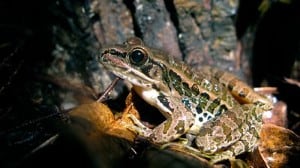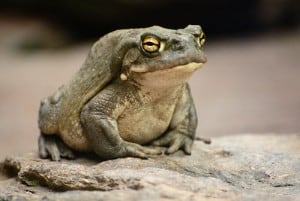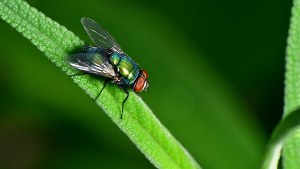
One of my best friends tells a funny story about a Spaniel that he had.
One of the spaniel’s favourite party tricks was running up and down by their garden pond barking loudly whenever he spotted a frog.
I don’t think that the dog ever caught a frog but it kept him very fit!
But what should owners do whose dogs manage to lick a frog or even eat one?
Should it be an immediate phone call to a vet, or is it a “watch and wait” situation?
Read on to find out more!
Help! My dog has eaten a frog
If you believe that your dog has swallowed a frog then the chances are that nothing much will happen.
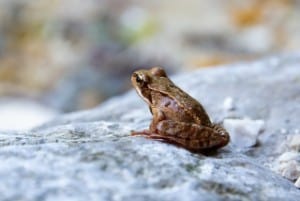
This is because in the US there is only one type of frog which is toxic to your dog and in the UK there are no poisonous frogs.
Your dog might vomit it back up because it is too slimy or your dog might get a touch of diarrhea from this new addition to their diet but it is as likely that your dog will just carry on as normal.
However, if your dog has swallowed a toad and not a frog then the chances of something bad happening are much greater.
This is because all toads as a defence mechanism secrete toxins from their skin.
And the level of poison in this toxin varies from leaving a nasty taste in a dog’s mouth to killing it.
And there is no antidote for frog or toad poisoning- no injection that your vet can give your dog when you take your dog in for an emergency appointment.
The only thing to do (and even your vet will tell you this) is a bit of a home remedy.
As quick as you can, you need to wash your dog’s mouth out with water.
Using a garden hose, spray water from the back of the mouth out of the front.
The reason for this is not only to “rinse” their mouth of as much toxin as possible, but by spraying from the back of the mouth towards the front of the mouth, you are stopping any toxin from being swallowed.
The vet in this video explains it step by step.
And now that I have explained what you should if your dog swallows a frog, I will know briefly go over some basic differences between frogs and toads
Four differences between a toad and a frog?
If your dog has just eaten a frog, would you be completely sure that it was a frog or a toad.
Because I’m not sure that I would be.
So what are the key differences between a frog and a toad?
| Amphibian | Skin | Habitat | Back Legs | Size & Shape |
| Toad | Wart like. Lots of bumps. | Visit water. Don’t live near it. | Shorter. Used for crawling not hopping | Chunky! |
| Frog | Sleek and smooth | Live near water. | Long legs, great for hopping. | Small, slim and sleek. |
So as the table above describes, for dog owners such as ourselves there are four main differences; skin, habitat, back legs and size and shape.
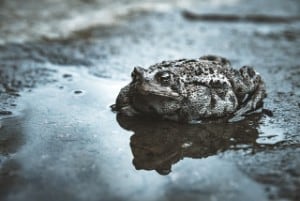
Skin
A frog has beautifully smooth skin which is shiny because it is wet most of the time.
A toad has “uglier” skin which is full of bumps and has a wart like texture. Their skin looks dry.
Habitat
Frogs live close to a pond and they spend more time in one because their skins can’t dry out.
Toads don’t necessarily live near a pond or river. They don’t need to be in water as much because their skin can tolerate being dry.
Back legs
Frogs back legs are very long in comparison to their size. This is because on dry land they spend most of their time hopping.
Toads on the other hand have very short back legs because they don’t hop but they crawl along the ground.
Size and shape
Frogs have a very fit, sleek and athletic look. They are slightly built- like long distance runners.
Toads, on the other hand, look like bouncers or door security at a nightclub. Their chunky look is not built for speed!
Having explained those basic differences it is time to move on and discuss what frogs or toads are toxic or poisonous for your dog.
And to do this, I will look at frogs and toads that can be found in the US and the UK separately.
Three poisonous frogs and toads that live in the US
I can’t find an exact figure for the total number of frog and toad species that live in the US.
I do know that there are about 300 species of amphibians that live there though.
I have managed to find this interactive frogwatch list.
Just click on the state that you live in to find the frogs that live near you!
But I do know that there is one poisonous species of frog and two poisonous species of toads that can potentially kill your dog.
Let me introduce the first suspect…
[1] Pickerel frog
There is only one poisonous frog in the US and that is the Pickerel frog.
It is quite a large frog and can be up to 4 inches long (or 7.5 cm).
It’s distinguishing features are very dark and almost square shaped spots that run along its back.
They can be found in ponds or streams with fairly clear water across most of the eastern half of the US.
If you were to draw a line through Wisconsin, Illinois and down through Mississippi. Most of the states to the east of that boundary will have populations of Pickering frogs.
When threatened, their skin secretes a toxin which is mildly irritating.
It is not life threatening to dogs but hopefully it will send a message that they need to be more careful next time.
[2] Cane toads
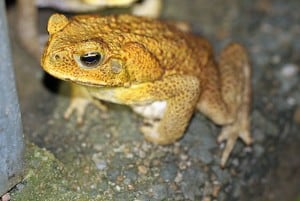
Cane toads are poisonous and could easily kill a dog in as little as fifteen minutes.
They are ugly and unpopular.
So much so, that Florida residents have been told to kill any that they find.
And they are huge- they are the world’s largest toad and can grow to be up to nine inches long!
Fortunately as far as the US is concerned they live in a very limited area around central and south Florida.
They are an invasive species, who were introduced to control pests in sugar cane fields.
But when they were introduced in Australia in the 1930s, they were far better at breeding than they were at protecting sugar cane!
They will eat anything that they can, which includes small mammals and any pet food which is left out at night!
Symptoms of Cane Toad poisoning
[3] Colorado River toads
Another lethal killer as far as some dogs are concerned.
The toad also goes by the name Sonoran Desert toad and they can grow up to 7.5 inches long.
Apart from its size, its mottled olive skin is a distinguishing feature.
It has glands by its mouth, behind its ears and on its legs and these glands secrete the chemicals 5-MeO-DMT and bufotenin.
These are both hallucinogenic tryptamines, which as well as having the potential to kill a dog, will also get a person high in as little as 15 seconds and for as long as an hour.
If a dog isn’t killed by the secretions then it will probably be paralysed for a few hours.
What are the symptoms of Colorado Toad poisoning?
If your dog has licked, bitten or swallowed a Colorado Toad then you will see various signs of distress such as foaming at the mouth, vomiting, or pawing at the mouth or eyes.
These toads inhabit parts of Colorado, California, New Mexico and Arizona.
It lives in desert and semi arid areas and can be found near streams, canals and springs.
Having described the one poisonous frog and two poisonous toads that dogs in the US might stumble across, it is time to turn our attention to the UK.
What poisonous frogs or toads live in the UK?
It is not a surprise to learn that the UK has a far smaller number of frog and toad species.
There are two species of toad resident in the UK and two species of frog- although one species of frog exists in very limited numbers.
None of the frogs are poisonous and only one variety of toad is.
And so let’s start with that one.
Common Toad
Compared to their US cousins, common toads are “small fry”.
A male can grow up to 8cm long but a female can grow to about 13 cm (5 inches.)
Their rough skin is normally an olive brown colour.
They prefer to live in woodland, scrub or grasslands.
And they can be found in most geographical areas of the UK, except Ireland.
These toads are poisonous and when they feel threatened, they secrete a thick milky substance.
The larger the common toad, the more poisonous they tend to be because their glands are larger.
Symptoms of Common Toad poisoning
If a dog has swallowed or licked a common toad then they will be suffering from hypersalivation and some excess frothing at the mouth,
Natterjack Toad
Unlike the Common Toad, the Natterjack is nowhere near as widespread.
And it isn’t toxic- it secretes a nasty tasty substance but it is nowhere near as toxic as the secretions of a Common Toad.
It lives in coastal sand dunes, coastal grazing marshes and on sandy heaths.
It’s main populations are on the Cumbrian and Norfolk coasts in England and the Kerry coast in Ireland.
In terms of size, mature adults will measure up to 7 cm and so they are slightly smaller than most male Common Toads.
Natterjacks can be a grown or green colour and a distinguishing feature is a yellow stripe along its back.
Having looked at the UK’s two species of toads, I want to move onto their population of frogs.
Common frog
Although there are two species of frogs in the UK, the overwhelming majority of frogs are Common Frogs.
The Common Frog isn’t toxic or poisonous to your dog. It doesn’t secrete anything through its skin when it feels threatened.
And so to a dog that chooses to eat one, they are just a slimy protein snack.
They are called common because they exist in almost every part of the UK.
There are lots to be found in suburbia, where they depend on garden ponds to survive.
An adult can grow up to 9 cm long.
They are coloured by shades of olive, greens and browns with dark blotches of colour along their back
Pool frog
In the 1990s, Pool frogs were thought to be extinct in the UK but since then populations have been reintroduced in a couple of places in Norfolk.
Pool frogs are generally coloured brown with dark splotches on their backs.
They have a yellow stripe down their back.
Like the Common Frog, Pool Frogs are non toxic and they don’t secrete any toxins.
But, since their numbers are so limited your dog will be “lucky” to find one!

